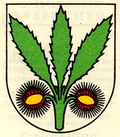Castagnola TI
| Castagnola | ||
|---|---|---|
| State : |
|
|
| Canton : |
|
|
| District : | Lugano | |
| Municipality : | Lugano | |
| Postal code : | 6976 | |
| Coordinates : | 719 006 / 95650 | |
| Height : | 333 m above sea level M. | |
| Residents: | 5509 (December 31, 1991) | |
| map | ||
|
|
||
Castagnola was an independent political municipality in the district of Lugano , Canton Ticino , Switzerland . In 1972 Castagnola merged with the municipality of Lugano and has since formed the Castagnola-Cassarate-Ruvigliana district .
history
In panoramic position above the Lake Lugano , at the foot of Monte Bre located, the community also included the fractions Ruvigliana and Suvigliana , the hamlet Cassarate in the plane and Caprino and Cavallino across the lake. First mentioned as Castigniola in 1335. Archaeological finds from Roman times were made in 1886 and 1938. In the Middle Ages there was a Castagnola, Ruvigliana and Suvigliana (1335) comprehensive concilium (neighborhood) around the old church of S. Giorgio. Castagnola became an independent parish in 1620.
Founded by the Bishop of Como and tax-free (cassina) Cassarate (1335 Casorago) was connected to the castle of S. Michele (located on the hill in today's park). The hamlet (burgus) disintegrated after the Middle Ages and the land passed to families in Castagnola and Lugano. The left arm of the Cassarate River was used by mills from the 17th century at the latest . Castagnola and Lugano jointly held the usufruct of both the sand and gravel pit at the mouth of the Cassarate and the municipal property in Caprino and Cavallino (cellars, sand and gravel pit, willow and wood). After 1850 Cassarate was integrated into the urban infrastructure of Lugano and in 1896 the tram line was terminated . The church of SS. Pietro e Andrea in Cassarate, which dates back to the early 16th century, serves as the private chapel of the Villa Castagnola, a hotel founded in 1885 .
Thanks to structural development and the hotel industry, Castagnola and its surroundings became the largest residential and holiday area around Lugano in the 20th century, and in 1908 by a funicular and in 1955 by a trolleybus line . Castagnola is known for its recreational areas and important cultural institutions such as San Michele Park (with a chapel from the 18th century), Villa Favorita (Thyssen-Bornemisza Foundation) and Casa Carlo Cattaneo (1849-69 residence of the political refugee of the same name ). The latter now houses the city archives of Lugano and a museum dedicated to the Latvian poets Janis Rainis and Aspazija (Elza Rozenberga) who lived in Castagnola from 1906-2020 . 1955–98 there was also a pharmaceutical company (Giuliani SA) domiciled in Castagnola .
population
| Population development | ||||||||||
|---|---|---|---|---|---|---|---|---|---|---|
| year | 1591 | 1801 | 1850 | 1900 | 1950 | 1970 | 1991 | |||
| Residents | 157 | 214 | 419 | 1,060 | 2,926 | 4,430 | 5'509 | |||
Attractions
literature
- Antonio Gili: Castagnola. In: Historical Lexicon of Switzerland . September 15, 2003 , accessed January 8, 2020 .
|
|
This version of the article is based on the entry in the Historical Lexicon of Switzerland (HLS), which, according to the HLS's usage instructions, is under the Creative Commons license - Attribution - Distribution under the same conditions 4.0 International (CC BY-SA 4.0). If the article has been revised and expanded to such an extent that it differs significantly from the HLS article, this module will be removed. The original text and a reference to the license can also be found in the version history of the article. |


